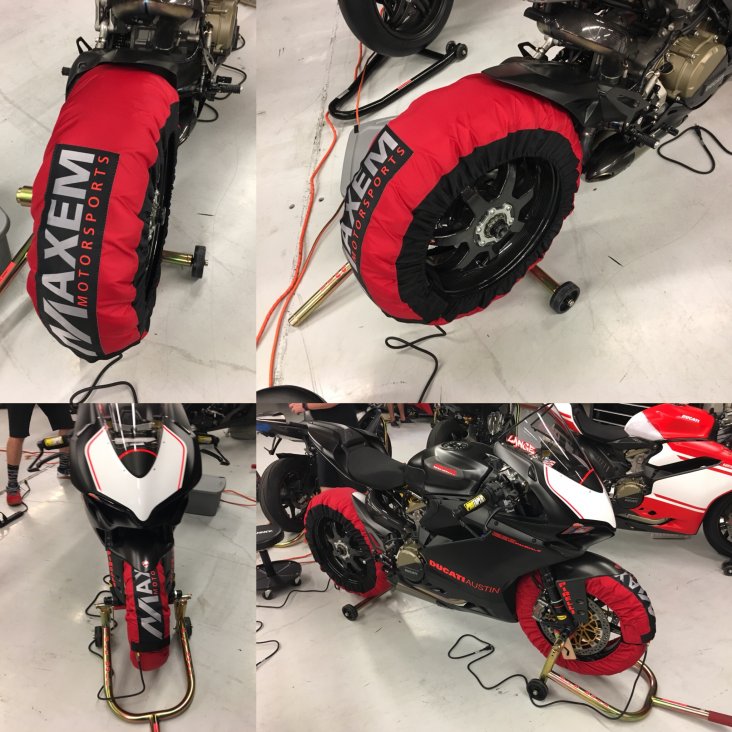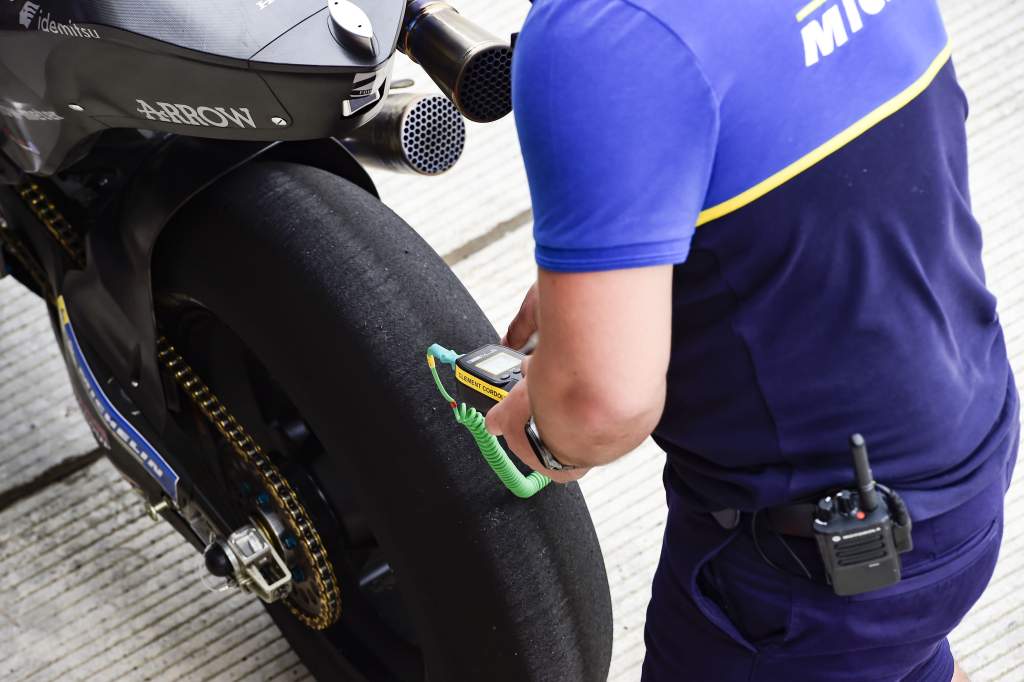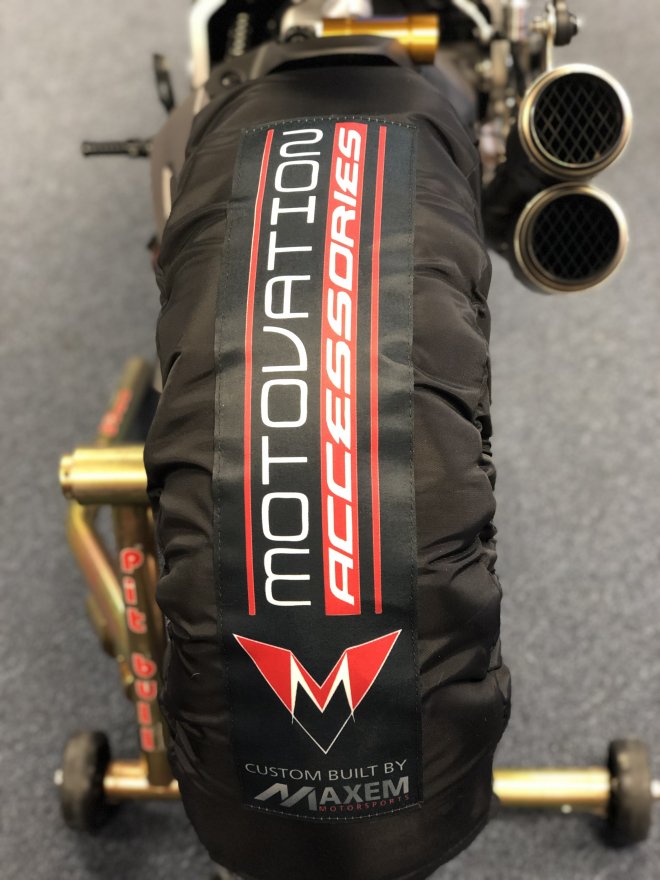Categories
Motovation Blog
- Jan 30, 2025 SC-Project Exhausts Announced as Title Sponsor for the 2025 MotoAmerica Twins Cup Racing Series The MotoAmerica Twins Cup series, known for its thrilling races and competitive spirit, showcases some of the finest up-and-coming talents and machines in the industry.
- Jan 9, 2025 Motovation Announced as Title Sponsor for 2025 MotoAmerica Supersport Class Motovation is thrilled to announce its title sponsorship of the 2025 MotoAmerica Supersport class.
What temperature should my tires be at the track?
Do I need to use tire warmers? Are my tire warmers hot enough?

This is a very common question we hear at track days. Many people are unsure if they should be using tire warmers, and what temperature they are actually heating your tires to.
Keep in mind, some of this information is subjective, and will be specific to your climate and overall track surface temperatures. We even notice some differences based on the actual power the bike is putting to the rear wheel.
Tire warmers are devices used in motorsport, particularly in racing, to heat up the tires of a vehicle before it hits the track. The primary goal of using tire warmers is to bring the tires up to the optimal operating temperature, which helps improve grip, handling, and overall performance during the initial laps of a race. The proper tire temp can also improve the life of your tires. If you are racing on a budget, that is important!

What temperature should my tire warmers be?
The ideal temperature for tire warmers on a sportbike can vary depending on several factors, including the type of tire, the track conditions, and the specific manufacturer's recommendations. However, a general guideline for most sportbike tires is to set the tire warmers to a temperature range between 80°C to 90°C (176°F to 194°F). Ideally we are trying to get close to matching the tire tread temperature, and the track surface temperature.
The best way to check tire temperature is to use a tire pyrometer. The best type of pyrometer has a probe that is inserted into the tire tread. By measuring temperature below the tread surface, the probe provides improved readings since the tire tread surface cools relatively rapidly. Here at Motovation, we always check our tire temps as soon as we get the bike back into the paddock. Even 20 seconds of cool down time can affect your accuracy, so check your temps right away!

Keep in mind that different tire compounds and brands might have different temperature recommendations, so it's crucial to consult the manufacturer's guidelines or the tire supplier's recommendations for your specific tire model. Often times we do not recommend tire warmers for riders that are running street compound tires, or riders that are not maintaining enough overall track speed to keep the heat in the tires. If you are not riding fast enough to keep the heat in the tires, you wont want to experience the tire temperature fluctuations while you are out on track.
Additionally, it's essential to monitor the temperature closely during the warming process to avoid overheating the tires, as excessive heat can negatively impact tire performance and longevity.
Here's how tire warmers work:
-
Construction: Tire warmers are typically made of insulating material, such as neoprene or silicone rubber, and they are shaped to fit snugly around the tires. The warmers are designed to cover the tire's tread area entirely and may have elastic bands or other fastening mechanisms to keep them securely in place.
-
Heating elements: Inside the tire warmers, there are heating elements, usually electrical wires or heating coils, embedded in the insulating material. These heating elements are responsible for generating heat.
-
Temperature control: Tire warmers are equipped with thermostats or temperature controllers. These control mechanisms allow the user to set and maintain a specific temperature. The ideal temperature depends on the type of tire and the racing conditions but typically ranges from 80°C to 100°C (176°F to 212°F).
-
Power source: Tire warmers are powered by electricity, and they require a power source to operate. Most tire warmers come with a plug that can be connected to a standard electrical outlet or a generator at the race paddock.
-
Pre-race preparation: Before the race, the tire warmers are placed over the tires, and the heating elements are activated. The warmers begin to heat the tires to the desired temperature.
-
Heat retention: Once the tires reach the desired temperature, the insulating material helps retain the heat, preventing it from dissipating quickly. This allows the tires to stay at the optimal temperature until they are removed right before the vehicle goes on the track.
-
On-track benefits: When a vehicle with preheated tires hits the track, it has an advantage because the tires are already in their optimal operating temperature range. This results in improved grip, reduced tire wear, and better handling, especially during the first few laps when the tires are naturally cold.
It's important to note that tire warmers are not typically used in everyday driving or regular road use. They are specific to racing scenarios where maximizing performance during the early stages of a race is crucial.

Note: ALWAYS disconnect the power to your tire warmers when you leave the pits to head out on track. This is to avoid any potential overheating or safety concerns. But keep in mind that it can take a full 20 minutes to get your tires up to proper operating temperature when using warmers.

